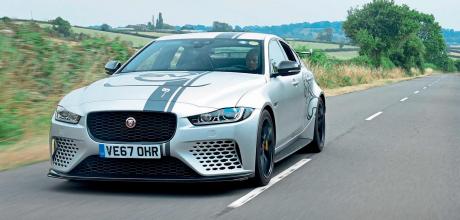2017 Jaguar XE SV Project 8 Prototype
It could have ended up in the crusher when its work as a development hack was over, but this early XE SV Project 8 prototype was saved by Jaguar Heritage and we’ve taken it for a scary spin.
WORDS & PHOTOGRAPHY PAUL WALTON
MODERN DRIVE XE SV PROJECT 8 PROTOTYPE
Lucky escape
Driving the Project 8 prototype
Driving the savagely fast supercharged V8 limited edition on the public roads
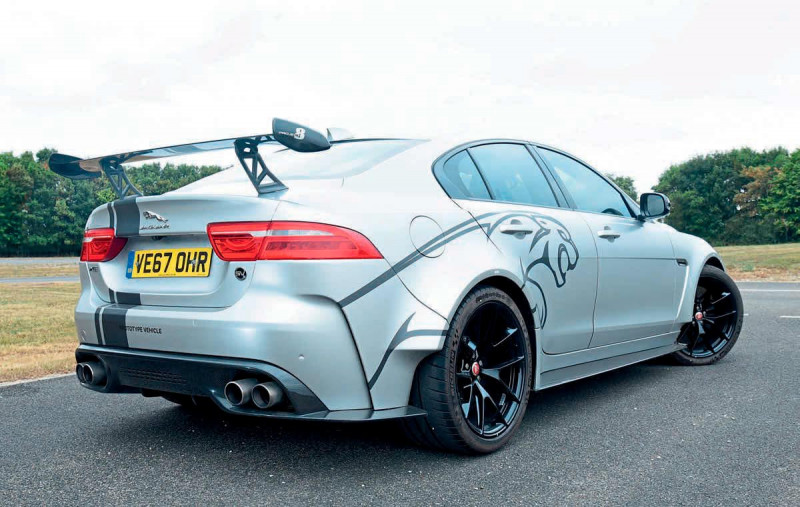
Said the late Japanese fashion designer, Issey Miyake, once, “I am not sentimental about the past. I like to think about what is next.”
This is view taken by most manufacturers when it comes to the cars used to develop new models. Despite their cost and potential place in history, by being rough, ready and often unfinished prototypes, these hard-worked hacks are often destroyed without a second’s thought.
There are rare exceptions though, such as the crude X100 mule we featured in the December 2021 issue. Another is this SV Project 8. Used to develop Jaguar’s latest and probably final saloon-based supercar, it has managed to dodge the crusher to spend its retirement in the safe hands of the Jaguar Daimler Heritage Trust.
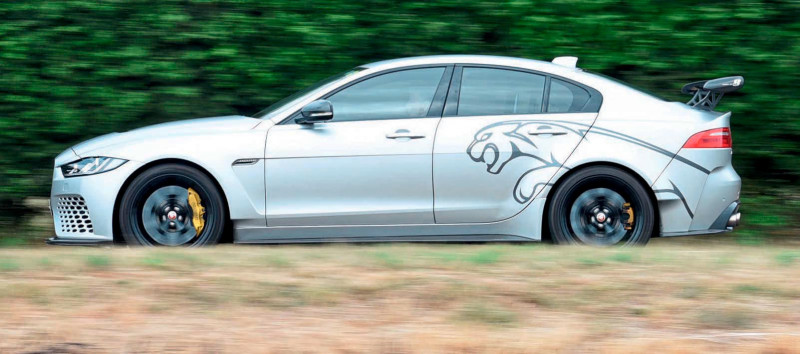
Jaguar’s Special Vehicle Operations, the company’s top-secret skunkworks based at Prologis Park outside Ryton-on-Dunsmore, six miles south of Coventry.
It followed SVO’s first official project, the F-TYPE Project 7 from 2014, that saw an increase of power and performance over the standard V8 R model. Yet the SV Project 8 would be a much bigger, bolder car, with the XE saloon needing to be comprehensibly reengineered to handle the 600PS (592bhp) version of Jaguar’s supercharged 5.0-litre V8 it came with. These changes included a new carbon fibre panels such as the bumpers and bonnet that resulted in the car weighing just 1745kg, a mere 200kg more than an XE 2.0D despite the much heavier V8 at the front. There were also wildly flared arches to cover 20in forged aluminium alloy wheels while adjustable front splitter, flat underbody, rear diffuser and adjustable rear wing gave the car a very aggressive image.
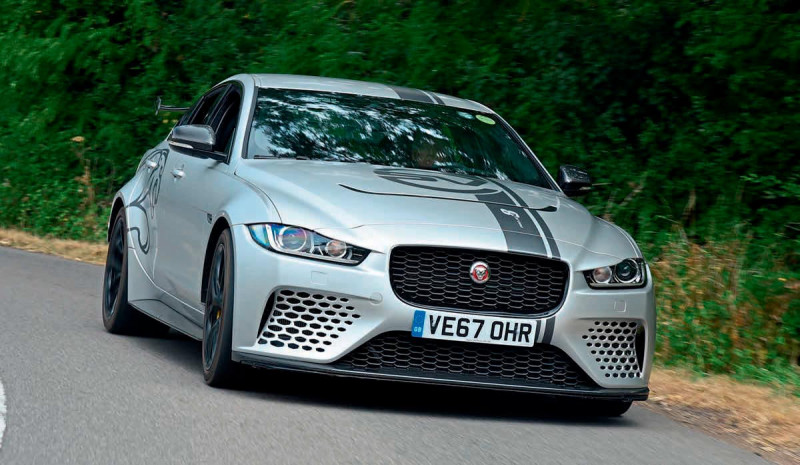
It had stiffer springs and manually adjustable Continuously Variable Dampers, giving a 15mm lower ride height for track use, a new carbon ceramic braking system plus an industry-first use of Formula 1-style silicon nitride ceramic wheel bearings on a road car. There was also an electronic active differential (EAD) with oil cooler, the first time this was fitted to an XE.
The result was a four-door saloon but with a supercar performance; top speed was 200mph while its 3.3 second dash to 60mph made it the fastest accelerating Jaguar ever.
The always hedonistic motoring press were naturally impressed by the car and all that power. “There are seemingly endless reserves of power, and as the needle on the rev counter swings around to the red line it’s easy to believe the claimed 0-60mph time of 3.3 seconds – if anything, the Project 8 feels quicker still,” said Auto Express in 2018.
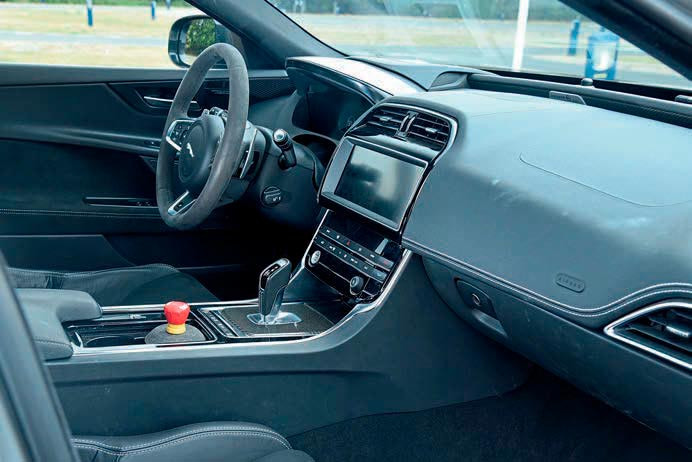
“Just as impressive is the ear-splitting noise that accompanies it; the bellowing, crackling exhaust note is pure NASCAR. It’s not subtle, but then you don’t buy a car like this to blend into the background.”
SVO built a number of prototypes to develop the model that spent the majority of their time pounding around the 12.9-mile Nürburgring where Jaguar (along with most other manufacturers) has a permanent test facility. In November 2017 Jaguar sent out a press release that announced that at 7min 23 secs the car had broken the lap record for four-door saloons.
Recognising the Project 8’s significance in the history of the company, Jaguar Daimler Heritage Trust felt an example needed to be part of its collection of important cars. But with only 300 built which cost a hefty £150k, it was never going to be allocated a production model. And so Heritage contacted SVO to enquire whether there was a prototype it could secure. SVO’s engineers replied that they’d all been destroyed bar one that was retained to develop the Touring specification that featured a smaller, more discreet wing. Pleased that not all of its work would be destroyed, SVO agreed to give Heritage the car. It even offered to remove the large red kill button in the middle of the interior and tidy up the boot lid where the grey wrap had been worn due to different styles of rear spoiler being taken on off to reveal the car’s original white paint beneath. Heritage, though, declined, wanting the car to remain what it is, a rare yet important example of a development prototype.
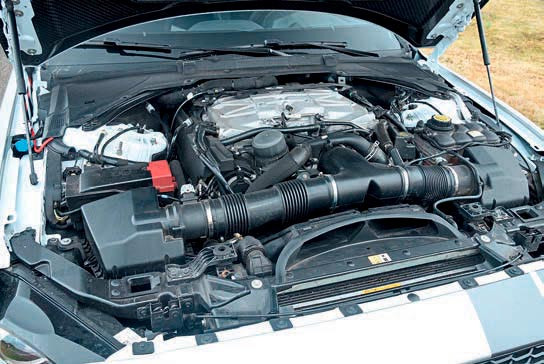
Yet unlike that early X100 that hasn’t turned a wheel under its own steam in decades, the grey Project 8 is usable, road legal and I’ve been given a special permission to drive it.
Already parked outside JDHT’s British Motor Museum-based facility when I arrive, I’m struck by what an angry and aggressive looking-car the Project 8 is. Hard, angular and with more air vents than nuclear bunker, it wasn’t so much designed as eroded by wind.
It’s also clear by the occasional mark in the grey wrap that this example has had a previously hard life. But like the pockmarked face of an old salty sea captain, these help to give it a bigger character than an immaculate, barely used example would have. It’s also surprisingly well-finished for a test hack, with all the wings, vents and splitters of the production version. But that’s why manufacturers use the Nürburging, its relative secrecy meaning prototypes like this don’t need to use camouflage like they do on the road. Only a discreet sticker on the rear bumper saying PROTOTYPE VEHICLE reveals its former life.
As well as the smaller, touring pack boot spoiler, the car was also used for emissions certification, electrical integration sign off (including parking sensor tuning), static part fitment trials, wind tunnel aerodynamic development at FKFS Stuttgart plus fume ingress testing at the Millbrook testing ground in the UK. In May 2018 the car was transported to Autódromo Internacional do Algarve in Portugal for the Project 8’s press launch when it was driven on track by 30-plus journalists over ten days, completing 1800 miles of hard track work.
After heaving myself into the restrictive carbon fibre shell bucket seats that are tighter than anything Ryanair has to offer, I immediately notice that red kill switch located between the front seats. It’s often fitted to development cars like this so everything can be instantly shut off in case of an accident, but I hope I don’t need it. There’s also a small plaque under the windscreen that says this is number one of 300 Project 8s. This makes the car equally as important as the first S-TYPE, X-TYPE, X350 XJ, X150 XK and X250 XF that are also part of the Heritage collection.
What’s surprising is other than the seats, the interior is largely identical to a standard model which is pretty poor for a car that cost twice that of my first house. There aren’t even any rear seats, since they’ve been removed to make room for a roll cage. And then I press the starter button on the dash and the 5.0-litre V8 erupts with a gravelly and distinctive bark that’s so loud I swear a couple of birds fell from the sky. Its interior might be ordinary but it’s immediately clear the performance won’t be. Yet as I head out of the museum’s car park, I’m immediately struck by two things; firstly, despite its previously hard life, the car still feels amazingly tight, being no different to the brand new production model I tested at Silverstone for our April 2019 issue. Plus unlike most bonkers supercars I’ve driven, it’s comfortable to trickle along at a slow speeds making it surprisingly docile. It’s so easy to drive I could imagine taking this car shopping although to do so would be a bigger waste than wearing my best suit to the supermarket.
And then I reach the main road when I give the throttle a properly hard shove. With almost 600bhp, the supercharged V8 responds instantly, rewarding me with an acceleration so urgent it takes my breath away like the super scary-dive Oblivion ride at Alton Towers.
With the 5.0-litre producing 516lb.ft of torque, the power is endless, the revs arriving in huge dollops until, with the V8 now screaming like Spitfire’s Merlin during a dog fight, I finally use the steering mounted paddles to change up. The eight-speed box reacts instantly, banging into gear with the same aggressive urgency as a bullet leaving a gun.
The super-strong carbon discs allow me to brake late and hard for a sharp bend, the steering being pinpoint accurate and perfectly weighted. With its heavily beefed up suspension, there’s less body roll than a four-door saloon – even a fast one – usually suffers from allowing me to carve through the bend at a tremendous pace. With the road straightening out ahead of me, I’m soon back on the power and with the engine again responding instantly I’m soon hurtling through the beautiful Warwickshire countryside like a vinyl-wrapped missile.
It’s an addictive experience but one I never take for granted, always remaining respectful of the Project 8’s tremendous fire power. One wrong move and I would need more than a kill switch to extract me from a tree.
A remarkable car, then, but with Jaguar moving to electric only by 2025, I can’t imagine it will develop a replacement. If that’s true and the SV Project 8 is the last of the company’s ultra-extreme models, then there’s no better way to become sentimental about the passing of the breed than this now preserved prototype.
Thanks to: Jaguar Heritage Trust (www. jaguarheritage.com)
The Project 8 touring pack that his grey prototype helped to develop.
Kill switch in cupholder betrays the car’s prototype status. Carbon-ceramic discs and six-pot calipers are devastatingly effective.
Although the car was used to develop the discreet Touring spoiler, it currently wears the big adjustable wing which can provide 55kg of downforce at 186mph


